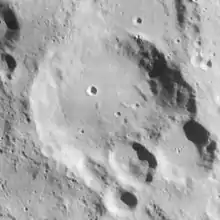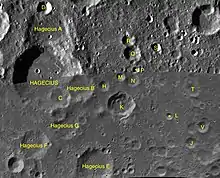Hagecius (crater)
Hagecius is a lunar impact crater in the southeastern part of the Moon's near side. It was named after 16th century Czech naturalist Tadeáš Hájek (Latinized as Thaddaeus Hagecius).[1] This crater forms a triangular formation with the craters Rosenberger to the north-northwest and Nearch to the west-northwest. Like both of these craters, Hagecius has undergone erosion from subsequent impacts, and its outer rim is worn and irregular. The southeastern rim in particular is overlaid by three smaller craters designated Hagecius C, B, and G.
 Lunar Orbiter 4 image | |
| Coordinates | 59.8°S 46.6°E |
|---|---|
| Diameter | 80 km |
| Colongitude | 316° at sunrise |
| Eponym | Tadeáš Hájek |
The interior floor of Hagecius is a level plain with no significant rises. There is a small craterlet to the northwest of the midpoint, and a few tiny craterlets marking the southeastern half of the floor. About a third of the interior floor on this side is also overlaid by the outer ramparts of the three satellite craters mentioned above.
To the northeast of Hagecius is the crater Biela, a younger formation with more distinctive features.
Satellite craters


By convention these features are identified on lunar maps by placing the letter on the side of the crater midpoint that is closest to Hagecius.
| Hagecius | Latitude | Longitude | Diameter |
|---|---|---|---|
| A | 58.2° S | 47.2° E | 61 km |
| B | 60.4° S | 48.9° E | 34 km |
| C | 60.7° S | 47.5° E | 24 km |
| D | 57.1° S | 47.0° E | 17 km |
| E | 63.3° S | 49.1° E | 44 km |
| F | 62.3° S | 44.8° E | 36 km |
| G | 61.8° S | 47.6° E | 30 km |
| H | 60.4° S | 50.7° E | 13 km |
| J | 62.6° S | 57.8° E | 14 km |
| K | 61.2° S | 52.0° E | 31 km |
| L | 61.5° S | 55.7° E | 8 km |
| M | 60.0° S | 52.0° E | 10 km |
| N | 60.2° S | 53.1° E | 16 km |
| P | 59.8° S | 53.2° E | 7 km |
| Q | 59.2° S | 53.0° E | 20 km |
| R | 58.7° S | 52.7° E | 15 km |
| S | 59.0° S | 54.6° E | 10 km |
| T | 60.6° S | 57.4° E | 14 km |
| V | 61.9° S | 58.3° E | 14 km |
See also
- 1995 Hajek, asteroid
References
- "Hagecius (crater)". Gazetteer of Planetary Nomenclature. USGS Astrogeology Research Program.
- Andersson, L. E.; Whitaker, E. A. (1982). NASA Catalogue of Lunar Nomenclature. NASA RP-1097.CS1 maint: ref=harv (link)
- Bussey, B.; Spudis, P. (2004). The Clementine Atlas of the Moon. New York: Cambridge University Press. ISBN 978-0-521-81528-4.CS1 maint: ref=harv (link)
- Cocks, Elijah E.; Cocks, Josiah C. (1995). Who's Who on the Moon: A Biographical Dictionary of Lunar Nomenclature. Tudor Publishers. ISBN 978-0-936389-27-1.CS1 maint: ref=harv (link)
- McDowell, Jonathan (July 15, 2007). "Lunar Nomenclature". Jonathan's Space Report. Retrieved 2007-10-24.CS1 maint: ref=harv (link)
- Menzel, D. H.; Minnaert, M.; Levin, B.; Dollfus, A.; Bell, B. (1971). "Report on Lunar Nomenclature by the Working Group of Commission 17 of the IAU". Space Science Reviews. 12 (2): 136–186. Bibcode:1971SSRv...12..136M. doi:10.1007/BF00171763.CS1 maint: ref=harv (link)
- Moore, Patrick (2001). On the Moon. Sterling Publishing Co. ISBN 978-0-304-35469-6.CS1 maint: ref=harv (link)
- Price, Fred W. (1988). The Moon Observer's Handbook. Cambridge University Press. ISBN 978-0-521-33500-3.CS1 maint: ref=harv (link)
- Rükl, Antonín (1990). Atlas of the Moon. Kalmbach Books. ISBN 978-0-913135-17-4.CS1 maint: ref=harv (link)
- Webb, Rev. T. W. (1962). Celestial Objects for Common Telescopes (6th revised ed.). Dover. ISBN 978-0-486-20917-3.CS1 maint: ref=harv (link)
- Whitaker, Ewen A. (1999). Mapping and Naming the Moon. Cambridge University Press. ISBN 978-0-521-62248-6.CS1 maint: ref=harv (link)
- Wlasuk, Peter T. (2000). Observing the Moon. Springer. ISBN 978-1-85233-193-1.CS1 maint: ref=harv (link)